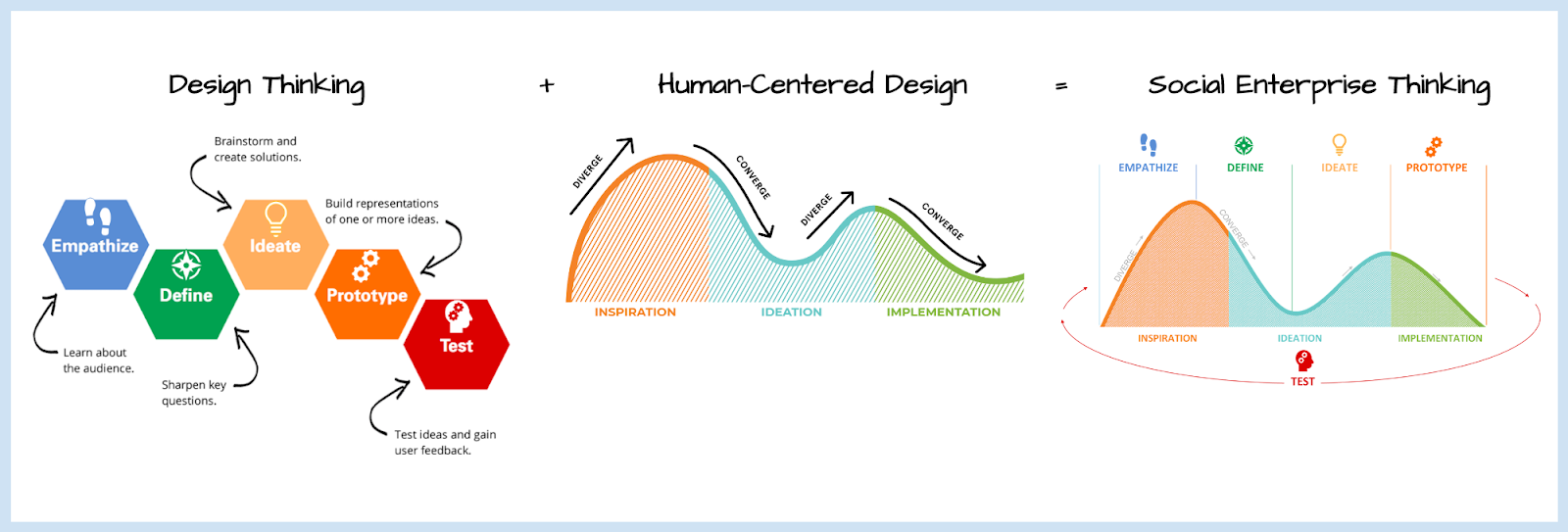Learn Human-Centered Design for Social Impact with our #LearnHCD Series
Learn Human-Centered Design for Social Impact with our #LearnHCD Series
Best practices, resources, and valauble lessons from our MovingWorlds Institute.
What is human-centered design?
Human-centered design (HCD) is a creative approach to problem solving that starts with the people you’re designing for and ends with new solutions that solve real problems.
Popularized by IDEO in the last decade, HCD is a proven framework that anybody can use to create better outcomes. It's a mindset that starts with understanding that solutions lie in the communities where the problem is experienced. From there, the HCD process follows 3 simple steps: inspiration, ideation, then implementation.
The three phases of the human-centered design process
Phase 1: Inspiration
In the Inspiration Phase, you’ll learn directly from the people you’re designing for as you immerse yourself in their lives, empathize with them, and truly understand their needs.
Phase 2: Ideation
In the Ideation Phase, you’ll make sense of what you've learned, define a solvable problem, brainstorm and identify ideas, then prototype possible solutions.
Phase 3: Implementation
In the Implementation Phase, you’ll bring your solution to life, test it to ensure it will truly make an impact, and then identify ways to scale it up.
It’s not ‘us versus them’ or even ‘us on behalf of them.’ For a design thinker, it has to be ‘us with them.'
How to get started using human-centered design
One of the biggest myths we bust in teaching MovingWorlds Institute Global Fellows human-centered design is that you need formal training, a fancy guide, or even a big team to get started. All you need to start is to believe in yourself and maintain your sense of curiosity and humility. You can get started today, and what we find is that every small HCD action you take will rapidly build your skills and confidence to do more. So how do you ACTUALLY start?
The IDEO Field Guide for Human-Centered Design (online version here) and Luma's Guide for Designing for Humans suggest practical things you can do, regardless of resources and buy-in. Our suggestion: pick one task in the “ideation” phase, like an observation exercise, and get started today! As Ernesto Sirolli recommends in the video below, remember to “Shut up and Listen”
Design thinking vs. human-centered design
There are a lot of similarities between these two approaches, but they have some notable differences. We think of it this way: design thinking is a proven process that will help you develop a product that people will adopt. Human-centered design is a framework that ensures what you’re creating is done in partnership with the people you are striving to support, and will make their lives better. Dive into the details with this comparison on our blog.

Human-centered design for social impact
Human-centered design is a tool for social impact that leverages the knowledge and innovation of the community the solution is being designed for. No one has a deeper understanding of the daily realities and nuances of a challenge than the people or organization facing that challenge every day. As such, human-centered design as a mindset and process will help you work in partnership to create a solution that actually meets the most pressing needs and creates lasting change. You can see real world-examples of how HCD has been used to create a social impact in the case studies in IDEO's Design Kit.
Human-centered design case studies, resources, and stories

How 3 Global Fellows Are Making Human-Centered Design More Accessible for Social Impact

Human-Centered Design vs. Design Thinking

An Introduction to Human-Centered Design

Resources and Methods To Help You Master Human-Centered Design

HCD in Action: Case Studies 1 & 2

HCD in Action: Case Studies 3 & 4

Putting Human-Centered Design Into Action as a Skills-Based Volunteer
It is about them and for them. The closer the end-users’ needs are analyzed and answered, the more successful the adoption or purchase of a solution. You iterate until you get it right from a customer perspective. This the power of HCD.